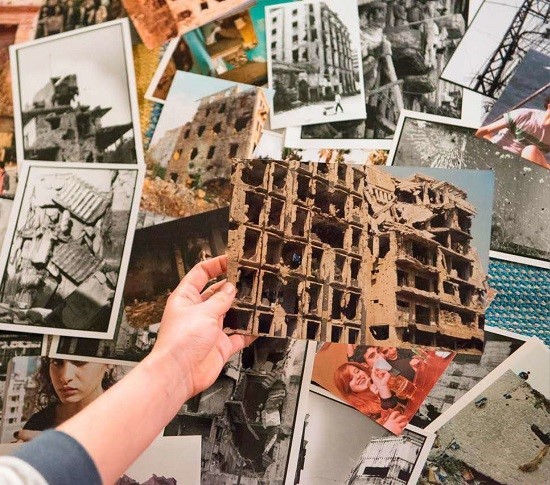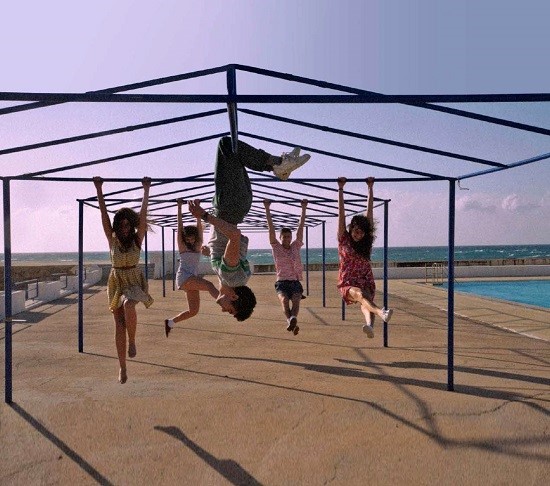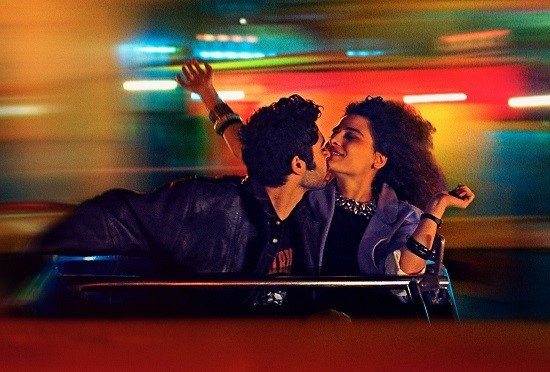“
Memory Box”, one of
the Lebanese films screened as part of the Lebanese film days organized by the
Royal Film Commission and directed by Joana Hadjithomas and Khalil Joreige, is, as the title intimates, a
large box full of memorabilia, which comes through the mail from the depths of
time into Montreal, which is ravaged by a blizzard. It is filled to the brim
with photos, diaries and tapes of single parent Maia (Rim Turki) who had spent
her teenage years, in the 1980s, in the midst of the Lebanese civil war.
اضافة اعلان
Despite the interdiction, Maia’s too curious daughter Alex
(
Manal Issa) secretly begins to study the contents of the mysterious box and
comes across an episode in her family history that the withdrawn Maia was never
ready to talk about.
 (Photo: Handouts from Joana Hadjithomas and Khalil Joreige)
(Photo: Handouts from Joana Hadjithomas and Khalil Joreige)
In the first few minutes, “Memory Box” makes use of
multimedia visual aesthetics, with video calls and text messages popping up
with a “bing” dominate the screen and the directorial work of the filmmaker duo
Hadjithomas and Joreige, who are actually also at home in the field of media
art. This almost deliberately contemporary style, however, soon takes a back
seat to more classic media formatting when the film begins, through Alex, to
bring Maia’s memories to life and thus to appropriate her story piece by piece.
An exuberant moment in war-torn Lebanon in the 1980s
First, Alex takes pictures of the analogue photographs with
the cell phone camera, which Hadjithomas and Joreige in turn use as an
opportunity to animate the digital photo series as small stop-motion clips. The
analog and the digital, the contemporary and the historical – these supposed
contradictions quickly crystallize as one of the central themes of the film.
In these first passages of Alex’s immersion into the strange
life of the suddenly no longer so familiar mother, “Memory Box” also finds its
most beautiful moments.
 (Photo: Handouts from Joana Hadjithomas and Khalil Joreige)
(Photo: Handouts from Joana Hadjithomas and Khalil Joreige)
Like when, for example, volleys of rifles scorch the photo
paper and carpet bombing leaves burn marks for so long that the portrayed
people who are huddling closer and closer together hardly have any space left
in the rectangular photo. Or when the camera locates the lost protagonist in a
seemingly endlessly elongated, surreally deformed, interior space, yesterday
and today, historical document and subjective experience, memory and feverish
dream are impressively pushed one above the other.
A daughter’s plunge into her mother’s past
The drama is very classic: the mother does not want the
daughter to dig into her past, the viewer becomes curious about what dark
secret may be hidden there; at the daughter’s side, this becomes a mystery got
to the bottom.
“Memory Box” manages to keep curiosity up and increase it,
and then reveals, bit by bit, what Maia is trying to leave behind forever in
the box that gives the title. What also makes this journey into a distant time
and a foreign culture interesting is the cross-generational approach. While
Maia collected all her impressions in diaries, photo albums and on tapes in her
youth, her daughter is a true digital native.
 (Photo: Handouts from Joana Hadjithomas and Khalil Joreige)
(Photo: Handouts from Joana Hadjithomas and Khalil Joreige)
Alex lets her friends take part in social media as a matter
of course, as she reconstructs the secrets of her mother’s youth in Lebanon on
various media.
Nice visualization of photographed memories
The two worlds – the mother’s analogue memory collection and
the fast-paced communication culture in social media – merge nicely on a visual
level. When Alex looks at the bleached and blurred prints, the images come to
life in an animated way for the viewer. The playful way of portraying what Maia
went through in the civil war in Lebanon creates a successful contrast. The
horrors of war in no way lose their effect, but rather become more tangible and
memorable through the translation into modern stylistic devices.
All in all, the film did not take any great technical risks
and therefore has an almost documentary effect. This also ensures a better
closeness to life than if the atrocities were portrayed in an overdramatic
manner.
 (Photo: Handouts from Joana Hadjithomas and Khalil Joreige)
‘Memory Box’ scores with impressive musical moments
(Photo: Handouts from Joana Hadjithomas and Khalil Joreige)
‘Memory Box’ scores with impressive musical moments
“Memory Box” has its emotionally strongest moments when the
music of the 1980s effectively underscores the lifestyle of the young people in
Lebanon.
Western music, which also dominated the clubs there, enabled
the teenagers to shield themselves from external circumstances for a few hours.
Blondie’s “One Way or Another” was deliberately chosen as a narrative bracket;
if the song is then taken up again in the present, it is, on the one hand, to
keep the memory alive and on the other, to mark the restart into a better
future.
The figures remain a little pale
The mother and daughter team in Montreal is completed by the
grandmother, who at first, like Maia, tries to keep Alex from researching.
Unfortunately, emotionally, it is not always possible to take the audience on a
journey into the past. This is mainly due to the fact that the actresses
ultimately fail to bring to life characters with whom one likes to suffer and
celebrate. Until the end one cannot get rid of the feeling that the characters
are not giving free rein to their emotions and that they seem a bit inhibited.
Perhaps this is also due to our stamping through the often slightly theatrical
acting of Western actors in dramas of this kind. The chilled acting, however,
leaves a lot of potential.
The film is a strong contribution to the topic of culture of
remembrance, which draws its viewers’ attention with modern eyes to the
traumatic long-term effects of youth in civil war. The last spark does not jump
over emotionally, but the musical moments, the visual finesse and the meaningful,
positive ending still stick in the memory.
Without effort
In addition to documentary and fictional films, Hadjithomas
and Joreige also make installations, sculptures and performances, but their
multilingualism is particularly good for “Memory Box”.
It is amazing how the film does not think hard, despite its
multiple layers, but breathes and smiles at every moment. It is not just an
essay film about memory, it also tells stories, in the here and now, as in
then. It is a chaotic mashup, but also a smoothie and a touching film.
Read more Entertainment



